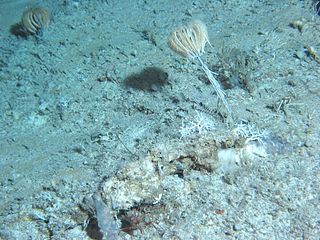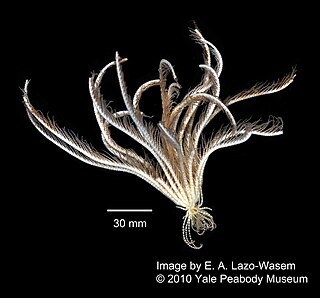
An echinoderm is any deuterostomal animal of the phylum Echinodermata, which includes starfish, brittle stars, sea urchins, sand dollars and sea cucumbers, as well as the sessile sea lilies or "stone lilies". While bilaterally symmetrical as larvae, as adults echinoderms are recognisable by their usually five-pointed radial symmetry, and are found on the sea bed at every ocean depth from the intertidal zone to the abyssal zone. The phylum contains about 7,600 living species, making it the second-largest group of deuterostomes after the chordates, as well as the largest marine-only phylum. The first definitive echinoderms appeared near the start of the Cambrian.

Crinoids are marine invertebrates that make up the class Crinoidea. Crinoids that remain attached to the sea floor by a stalk in their adult form are commonly called sea lilies, while the unstalked forms, called feather stars or comatulids, are members of the largest crinoid order, Comatulida. Crinoids are echinoderms in the phylum Echinodermata, which also includes the starfish, brittle stars, sea urchins and sea cucumbers. They live in both shallow water and in depths over 9,000 metres (30,000 ft).

An abyssal plain is an underwater plain on the deep ocean floor, usually found at depths between 3,000 and 6,000 metres. Lying generally between the foot of a continental rise and a mid-ocean ridge, abyssal plains cover more than 50% of the Earth's surface. They are among the flattest, smoothest, and least explored regions on Earth. Abyssal plains are key geologic elements of oceanic basins.

Sir Charles Wyville Thomson was a Scottish natural historian and marine zoologist. He served as the chief scientist on the Challenger expedition; his work there revolutionized oceanography and led to his being knighted.

The seabed is the bottom of the ocean. All floors of the ocean are known as 'seabeds'.

Comatulida is an order of crinoids. Members of this order are known as feather stars and mostly do not have a stalk as adults. The oral surface with the mouth is facing upwards and is surrounded by five, often divided rays with feathery pinnules. Comatulids live on the seabed and on reefs in tropical and temperate waters.

Davidaster rubiginosus, the orange sea lily, is a species of crinoid in the family Comatulidae. At one time it was classified as Nemaster rubiginosa but the World Register of Marine Species has determined that the valid name is Davidaster rubiginosus. It is found on reefs in the tropical western Atlantic and the Caribbean Sea.

Davidaster discoideus, the beaded crinoid, is a species of feather star in the family Comatulidae. It was previously known as Nemaster discoidea but the World Register of Marine Species has determined that the valid name is Davidaster discoideus. It is found on reefs in the Caribbean Sea and northern coast of South America.

Ocean dredging was an oceanography technique introduced in the nineteenth century and developed by naturalist Edward Forbes. This form of dredging removes substrate and fauna specifically from the marine environment. Ocean dredging techniques were used on the HMS Challenger expeditions as a way to sample marine sediment and organisms.

Metacrinus rotundus, the Japanese sea lily, is a species of stalked crinoid in the family Isselicrinidae. It is a species found off the west coast of Japan, near the edge of the continental shelf at a depth of around 100 to 150 metres deep. This is the shallowest-living species among the extant stalked crinoids.

Bourgueticrinida is an order of crinoids that typically live deep in the ocean. Members of this order are attached to the seabed by a slender stalk and are known as sea lilies. While other groups of crinoids flourished during the Permian, bourgueticrinids along with other extant orders did not appear until the Triassic, following a mass extinction event in which nearly all crinoids died out.

Cenocrinus is a monotypic genus of stalked crinoids in the family Isselicrinidae. The great West Indian sea lily is the only species in the genus and is found in deep waters in the Caribbean Sea and Gulf of Mexico.

Elpidia glacialis is a species of sea cucumber in the family Elpidiidae. It is found at abyssal depths in the Arctic Ocean, the Barents Sea, the Kara Sea and the North Atlantic Ocean. It was first described in 1876 by the Swedish zoologist Johan Hjalmar Théel after he had collected specimens while accompanying the explorer Adolf Erik Nordenskiöld on an expedition attempting to find the Northeast Passage.
Bathycrinus australocrucis is a species of sea lily, a crinoid in the family Bathycrinidae. It is native to the New Zealand region. It was described by D. G. McKnight.

Bathycrinus gracilis is a species of sea lily, a crinoid in the family Bathycrinidae. It is native to the North Atlantic. It was described by Charles Wyville Thomson.
Bathycrinus mendeleevi is a species of sea lily, a crinoid in the family Bathycrinidae. It is native to the Pacific Ocean west of South America. It was described by A. N. Mironov.

Bathycrinus is a genus of crinoids.

Endoxocrinus parrae is a species of stalked crinoids of the family Isselicrinidae. It is the most commonly found isocrinine species in west Atlantic Ocean.

Promachocrinus kerguelensis is a species of free-swimming, stemless crinoids. It was the only member of its genus until several species were discovered in 2023. P. keruguelensis a coldwater crinoid which is found in the seas around Antarctica and surrounding island groups, including under the sea ice.

Neocrinus decorus is a species of stalked crinoid, or sea lily, in the family Isocrinidae.

















